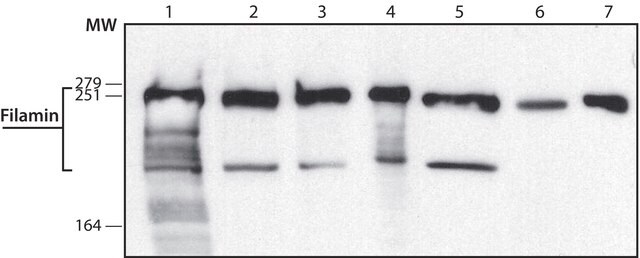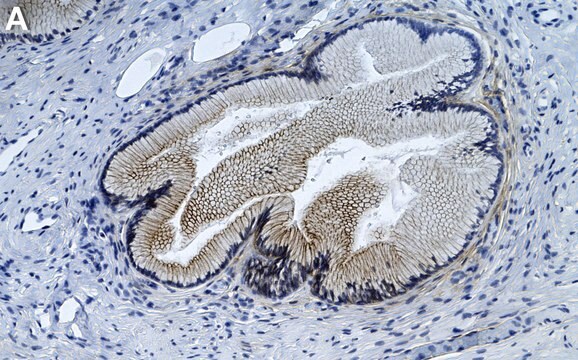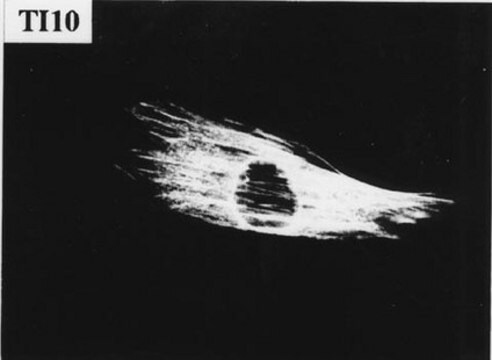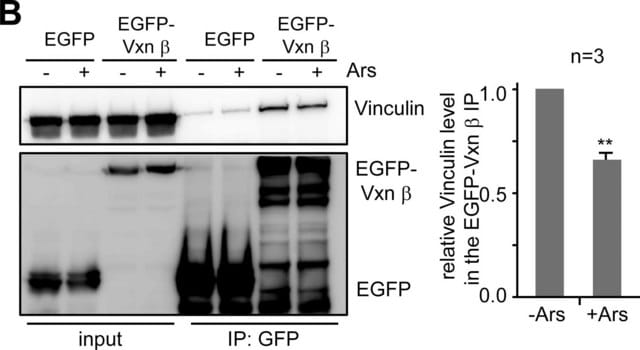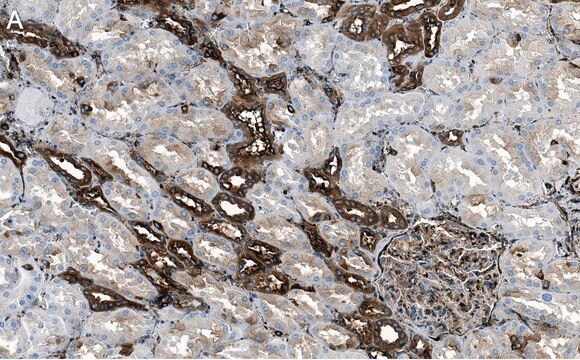General description
We are committed to bringing you greener alternative products, which adhere to one or more of The 12 Principles of Green Chemistry. This antibody is Preservative-free, produced without the harm or sacrifice of animals and exceptionally stable to allow for ambient shipping and storage if needed and thus aligns with "Waste Prevention", "Designing Safer Chemicals" and "Design for Energy Efficiency".
Click here for more information.
ZooMAb® antibodies represent an entirely new generation of recombinant monoclonal antibodies. Each ZooMAb® antibody is manufactured using our proprietary recombinant expression system, purified to homogeneity, and precisely dispensed to produce robust and highly reproducible lot-to-lot consistency. Only top-performing clones are released for use by researchers. Each antibody is validated for high specificity and affinity across multiple applications, including its most commonly used application. ZooMAb® antibodies are reliably available and ready to ship when you need them.
Specificity
Clone PM6/317 is a ZooMAb® mouse recombinant monoclonal antibody that specifically detects Filamin A.
Immunogen
Full-length, purified Filamin A from Human platelets.
Application
Quality Control Testing
Evaluated by Western Blotting in A431 cell lysate.
Western Blotting Analysis: A 1:1,000 dilution of this antibody detected Filamin A in A431 cell lysates.
Tested Applications
Western Blotting Analysis: A 1:1,000 dilution from a representative lot detected Filamin A in Jurkat cell lysate.
Flow Cytometry Analysis: 0.1 µg from a representative lot detected Filamin A in one million A431 cells.
Immunocytochemistry Analysis: A 1:100 dilution from a representative lot detected Filamin A in HeLa cells.
Immunohistochemistry (Paraffin) Analysis: A 1:100 dilution from a representative lot detected Filamin A in Human prostate and Human kidney tissue sections.
Note: Actual optimal working dilutions must be determined by end user as specimens, and experimental conditions may vary with the end user.
Target description
Filamin-A (UniProt: P21333; also known as FLN-A, Actin-binding protein 280, ABP-280, Alpha-filamin, Endothelial actin-binding protein, Filamin-1, Non-muscle filamin) is encoded by the FLNA (also known as FLN, FLN1) gene (Gene ID: 2316) in human. Filamin-A is a ubiquitous, cytoskeletal homodimeric protein that associates with actin filaments in the platelet cytoskeleton and links this structure to other structural/signaling proteins such as α-actinin and to membrane receptors such as the vWF receptor (GPIb-IX-V). It is also expressed in migrating neurons in the prenatal neocortex. Each Filamin-A monomer contains an N-terminal actin-binding domain, which is followed by 24 tandem immunoglobulin (Ig)-like domains interrupted by two flexible hinges. The two monomers dimerize through their C-terminal domain to generate the homodimeric form. Repeat 24 and the second hinge domain are shown to be important for dimer formation. Filamin repeat 20 interacts with filamin repeat 21 masking the ligand binding site on filamin repeat 21, which results in an autoinhibited conformation. This autoinhibition can be relieved by ligands like ITGB7 or FBLIM1. Filamin-A promotes orthogonal branching of actin filaments and links actin filaments to membrane glycoproteins. It anchors various transmembrane proteins to the actin cytoskeleton and serves as a scaffold for a wide range of cytoplasmic signaling proteins. It also plays a role in cell-cell contacts and adheren junctions during the development of blood vessels, heart and brain organs and plays a role in platelets morphology through interaction with SYK that regulates ITAM- and ITAM-like-containing receptor signaling. During the axon guidance process, Filamin-A is required for growth cone collapse induced by SEMA3A-mediated stimulation of neurons. Its phosphorylation at serine 2152 by PKA is reported to be negatively regulated by its autoinhibited conformation. This ZooMAb® recombinant monoclonal antibody, generated by our propriety technology, offers significantly enhanced specificity, affinity, reproducibility, and stability over conventional monoclonals. (Ref.: Ithychanda, SS., et al. (2015). J. Biol. Chem. 290(13); 8527-8538; Page, RC., et al. (2011). Acta Crystallogr. Sect F Struct. Biol. Cryst. Commun. 67(8); 871-876).
Physical form
Purified recombinant mouse monoclonal antibody IgG, lyophilized in PBS with 5% Trehalose, normal appearance a coarse or translucent resin. The PBS/trehalose components in the ZooMAb formulation can have the appearance of a semi-solid (bead like gel) after lyophilization. This is a normal phenomenon. Please follow the recommended reconstitution procedure in the data sheet to dissolve the semi-solid, bead-like, gel-appearing material. The resulting antibody solution is completely stable and functional as proven by full functional testing. Contains no biocide or preservatives, such as azide, or any animal by-products. Larger pack sizes provided as multiples of 25 µL.
Reconstitution
30 µg/mL after reconstitution at 25 µL per vial. Please refer to guidance on suggested starting dilutions and/or titers per application and sample type.
Storage and Stability
Recommend storage of lyophilized product at 2-8°C; Before reconstitution, micro-centrifuge vials briefly to spin down material to bottom of the vial; Reconstitute each vial by adding 25 µL of filtered lab grade water or PBS; Reconstituted antibodies can be stored at 2-8°C, or -20°C for long term storage. Avoid repeated freeze-thaws.
Other Notes
Concentration: Please refer to the Certificate of Analysis for the lot-specific concentration.
Legal Information
ZooMAb is a registered trademark of Merck KGaA, Darmstadt, Germany
Disclaimer
Unless otherwise stated in our catalog or other company documentation accompanying the product(s), our products are intended for research use only and are not to be used for any other purpose, which includes but is not limited to, unauthorized commercial uses, in vitro diagnostic uses, ex vivo or in vivo therapeutic uses or any type of consumption or application to humans or animals.


